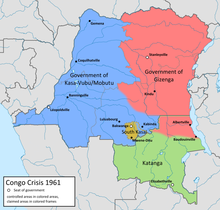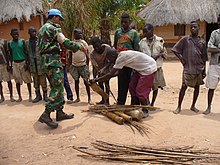Operation Grandslam
Indian peacekeepers exceeded their orders and crossed the Lufira River ahead of schedule, generating panic behind the Katangese lines and embarrassing the United Nations leadership.
[12] Initially, ONUC limited its actions to ensuring the safety of Congolese citizens and foreign nationals and refrained from acting against the secessionist states, but the UN ran into trouble in Katanga.
The state's leader and head of the locally entrenched Confédération des associations tribales du Katanga (CONAKAT), Moïse Tshombe, at first banned the UN from entering his territory and then greatly limited their peacekeeping efforts.
[19] United Nations Secretary-General Dag Hammarskjöld attempted to meet Tshombe for negotiations in Northern Rhodesia, but on the night of 17 September his plane crashed, killing all aboard.
It reaffirmed ONUC's ability to detain and deport foreign military personnel and mercenaries with force, described Katanga's secessionist activities as illegal, and declared the UN's support for the central government of the Congo in its efforts to "maintain law and order and national integrity".
He also demanded that Katangese forces cease military action in northern Katanga, end their supply blockade against UN troops at Sakania, and release detained Tunisian peacekeepers.
The United States Department of Defense shortly thereafter dispatched a team to the Congo to evaluate the UN's material requirements for carrying out an offensive and offered military intelligence aid to ONUC.
[42] Tshombe sent a letter to UN representative Eliud Mathu, accusing the peacekeepers of having obstructed the passage of Katangese government ministers on 24 December and engaging in "a general plan" of military operations.
[43] Radio intercepts also revealed to the UN that General Norbert Muke, the commander of the Katangese Gendarmerie, had ordered the air force to bomb the Élisabethville airport on the night of 29 December.
With the failure to enact a ceasefire, Major General Dewan Prem Chand of India convinced Thant to authorise a strong, decisive offensive to pre-emptively eliminate Katangese forces.
[48] Through reconnaissance, the UN had learned that these forces were concentrated on defending the southern tier of the province (much of the north was already under central government control), with about 5,150 troops in and around the towns of Jadotville, Kolwezi and Bunkeya.
Mercenary Jan Zumbach remained with the other portion of the air force in Portuguese Angola and did not intervene, infuriating Puren, who was ordered by General Muke to fall back to Jadotville.
Irish troops, detailed for the purpose because they spoke English and could communicate with Rhodesian border guards, then passed through at night and seized the town of Kipushi[60] without facing any resistance.
At 06:20 the company spearheading the advance came under heavy machine gun and mortar fire from the Katangese two or three kilometres northeast of Kamina and was ordered by Major Sture Fagerström to retreat 600 meters.
The same day Prime Minister Adoula received a letter from the chiefs of the most prominent Kantangese tribes pledging allegiance to the Congolese government and calling for Tshombe's arrest.
[73] Meanwhile, mercenaries in the Kolwezi area had taken Tshombe's threats about a scorched earth policy seriously and had planted explosives on all nearby bridges, the Nzilo Dam (which provided most of Katanga's electricity) and most of the UMHK mining facilities.
[3] Realising in a final meeting in Kolwezi that the situation was grim, Colonel Bob Denard suggested that, before fleeing, the mercenaries should destroy the Nzilo Dam to make a political statement.
[3] They concluded with Tshombe signing a formal instrument of surrender with Major General Chand and acting UN Civilian Chief George Sherry, officially ending the Katangese secession.
"[75] All the various political concerns about what ramifications a UN attempt to crush the secession might cause, such as a drawn-out guerrilla war or power vacuum, were virtually resolved with the successful conclusion of Operation Grandslam.
"[49] A subsequent investigation by an ONUC intelligence team found that 15 aircraft had been hidden at Angolan airfields for use, in the words of captured Belgian mercenaries, "in the next fight for Katanga's secession".
[4] According to a 1966 report prepared for the United States Arms Control and Disarmament Agency, two Belgian women were killed at a UN checkpoint at the outskirts of Jadotville by Indian peacekeepers after the male driver of the car they were in suddenly accelerated instead of stopping.
[81] A UN spokesperson acknowledged that from a military perspective the operation had been "brilliantly executed" but stated that the UN regretted the "serious breakdown in effective communication and coordination between United Nations Headquarters and the Léopoldville office.
Thant announced that Bunche's visit was for "a number of matters, political, military and administrative affecting the operation and its present and future activities," though his statement did little to disguise the reason for the trip from the international community.
"[83] According to UN official Eric S. Packham, it was unofficially suggested that the Indian government, in direct communication with Chand and impatient with the UN's progress in Katanga, unilaterally ordered Noronha's troops to seize Jadotville.
[83] Military researcher Walter Dorn speculated that Thant may have been personally sensitive to the issue of secession, having suffered from the bloody Karen conflict in his native Burma and witnessed the consequences of the Partition of India.
[86] Holding office during a time of widespread decolonisation in Africa and Asia, Thant was mindful of the precedent he was setting; recognising or encouraging secession in one country could allow it to spread to others with fractious consequences.
[45] Thant claimed that ONUC had used force "in self-defence under attack", though this was not strictly the case, as he had, in accordance with the Security Council resolutions, authorised UN troops to undertake offensive action.
[76] Tshombe's rivalry with Association Générale des Baluba du Katanga (BALUBAKAT) leader Jason Sendwe, a northern Katangese politician, led to ethnic violence in Jadotville in which an estimated 74 people were killed.
The weak central government was unable to effectively deal with the problem, so President Joseph Kasa-Vubu dismissed Prime Minister Adoula and requested Tshombe to replace him.
The United Nations Organisation Stabilisation Mission in the Democratic Republic of the Congo (known as MONUSCO under its French name) provided logistical and advisory assistance to local government officials, police and the military.









